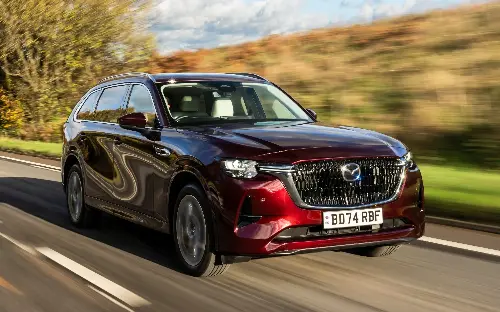
And so, to the eldritch forests of south-east Berkshire, a land ruled by the great seven-seat SUVs, which stalk the lanes of Windsor Great Park and lurk in the undergrowth, their capacious boots waiting to swallow any luckless Labradoodle that may stray within six feet.
It was here that Mazda brought us to launch its new CX-80, an interloper, but one that its maker hopes will be strong enough, indeed brazen enough, to mark out a territory all of its own.
However, of the CX-80’s established rivals, cars such as the Volvo XC90 and Land Rover Discovery dominate. These great beasts are to this part of the world as the tiny tuk-tuks to Thailand or pick-up trucks to Pennsylvania; beloved of their owners, who find them perfectly suited to the task in hand.
Is the upstart Mazda good enough to persuade them to leave the comfort and familiarity of their most trusted steeds?
Pros
- Beautifully executed interior
- Decent amount of space
- Good to drive
Cons
- Ride quality still unsophisticated
- Not as much room in the third row as rivals
- Expensive to buy
Diesel mild hybrid
There is a choice of two power-trains: one a plug-in hybrid (PHEV) based around a 2.5-litre petrol engine; the other a 3.3-litre six-cylinder diesel. We’ve tested the former, so now it’s the diesel’s chance to shine.
Diesel engines are not well loved in the UK, but the market suggests that buyers are starting to remember why the fuel was so popular only a few years ago, especially in large SUVs such as the CX-80.
Petrol engines in such vehicles are relatively thirsty and while hybrids might seem a solution, they rarely match the fuel economy of a good diesel.
And Mazda’s is just such a thing. Not only does it have the now de rigeur electric boost, from a 48V mild hybrid system, but it also has Distribution-Controlled Partially Premixed Compression Ignition, or DCPCI for short.
As its name suggests, this system partly pre-mixes the fuel and air before they are injected into the combustion chamber, allowing better distribution of both during compression, improving efficiency and – crucially – reducing NOx and particulate emissions.
The result is an engine developing 251bhp, enough to haul the two-tonne, five-metre long CX-80 to 62mph in a respectable 8.4 seconds, yet also return 40mpg in the real world.
More important than the performance figures is the mid-range torque; 406lb ft, to be precise. This doesn’t quite turn the CX-80 into a Discovery-rivalling tow car, but it’s still permitted to haul up to 2,500kg, which should suit most caravanners’ needs.
Well equipped – at a price
It’s not a bargain, however; prices start just shy of £50,000, while the diesel costs more than the hybrid. You only get a three-year, 60,000-mile warranty, too – which is stingy compared with some rivals, especially when Mazda provides a six-year, 93,000-mile guarantee in most other European countries.
Having said that, equipment levels are pretty generous; even the mid-range Homura tested here has Nappa leather seating, with heaters in both the front and outer rear seats and even coolers in the front ones. You also get a Bose sound system, ambient lighting, cruise control, satellite navigation, front and rear parking sensors, and a powered boot lid.
You can also choose to have your CX-80 with six seats, converting the middle-row bench into two captain’s chairs, at no extra cost.
If you think you’ve seen this car somewhere before, there’s a reason: the CX-80 is little more than an extended, seven-seat version of the CX-60. But, stung by criticism of the way the first CX-60s drove, Mazda has undertaken a hasty suspension re-jig on both – more on this later.
This is also why the CX-80 is largely identical to the CX-60 in front. This is no bad thing, given the CX-60’s dashboard layout and interior quality were its strongest points.
No touchscreen
There’s no touchscreen; instead, beautifully tactile physical buttons operate most of the major functions. Actually, there is a screen but it’s operated via a capstan controller in the centre console, which feels easier and more precise than stabbing at it with your finger and hoping.
It feels classy inside, too; broadly on a par with a modern Lexus, and somewhere between the utilitarian norm of a Kia Sorento or Skoda Kodiaq and the premium feel of a Volvo or Audi.
It’s in the back, of course, where the CX-80 differs from the CX-60. And the news is broadly good. Firstly, there’s plenty of space around between the middle and rearmost rows; if you’re sitting in the former, you can slide your seat forward to create leg room for those behind without impinging on your own too much.
In this way, it’s possible to seat seven adults in the CX-80. Those in the third row might feel a little hemmed-in, while they lack the extra climate controls of a Sorento or Santa Fe. But there are USB sockets and cupholders for each, at least.
If you regularly carry seven, a proper MPV such as the Volkswagen Multivan will do a better job. But among these large, seven-seat SUVs, the CX-80 holds its own – not quite as clever as the Hyundai and Kia, but still pretty good.
On the road
First impressions are that Mazda has attempted to inject a bit of its trademark driving sparkle. However, to do so, it has made the suspension firmer, so the CX-80 isn’t as smooth-riding as, say, a Santa Fe, clumping its big wheels into larger, sharper potholes. The suspension revisions mean it’s better than it would have been – judging by the early CX-60s – but still not ideal.
On the plus side, this tautness means excellent body control – the CX-80 doesn’t waft over larger undulations like some of these big SUVs can. And on a fast, flowing A-road it can be quite rewarding to hustle along, with a good amount of feedback through the controls, well weighted steering and a responsive front end.
It’s the engine that provides the most enjoyment, though. For a start, it sounds great; a warbly baritone grumble, that’s much more pleasing than the flat clatter you get with a four-cylinder diesel, or the reedy whine of a thrashing petrol hybrid.
And the instant torque it delivers means the CX-80 always feels satisfyingly gutsy, picking up neatly whether you’re in town or cruising at motorway speeds.
Should you choose the diesel instead of the PHEV? As long as you’re not choosing it as a company car, wherein the tax advantages of the hybrid power-train will make it much more financially sensible, then yes.
True, the hybrid’s extra weight means it does a marginally better job of flattening out bumps, although the diesel feels lighter on its feet and more agile in corners. And because it doesn’t have to blend responses from two power-trains in a hurry, like the hybrid, it feels more responsive.
The Telegraph verdict
How, then, will the CX-80 fare in the murky forests of suburbia? If there’s any justice, it should do pretty well. It probably isn’t going to make enormous waves – there are simply too many people who won’t countenance buying a Mazda instead of something with a posher badge.
More fool them. For the CX-80 is rather good at its job – and feels far more upmarket than you might expect. It’s pleasant to drive, practical and, most important, does without the touch-sensitive interior frippery that appears to be almost ubiquitous these days.
It doesn’t have the sort of ride and handling balance we’ve come to expect from Mazda – which, really, is its only serious failing. Even then, it’s far from a disaster in that regard.
The CX-80 is well worth a look. You may find yourself pleasantly surprised.
The facts
On test: Mazda CX-80 3.3 Skyactiv-D Homura
Body style: five-door SUV
On sale: now
How much? £55,355 on the road (range from £49,670)
How fast? 136mph, 0-62mph in 8.4sec
How economical? 41.3mpg (WLTP Combined)
Engine & gearbox: 3,283cc six-cylinder diesel engine, eight-speed automatic gearbox, four-wheel drive
Electric powertrain: 48V integrated starter-generator with 0.33kWh battery, no external charging facility
Electric range: 0 miles
Maximum power/torque: 251bhp/406lb ft
CO2 emissions: 148g/km (WLTP Combined)
VED: £270 first year, £600 next five years, then £190
Warranty: 3 years / 60,000 miles
Spare wheel as standard: no (not available)
The rivals
Hyundai Santa Fe Hybrid Ultimate
250bhp, 37.6mpg, £55,135 on the road
Hyundai’s blocky new Santa Fe looks fresher and more interesting than the Mazda and it’s also well-designed inside, with more space in the rearmost row of seats – and separate climate control for its occupants. The Santa Fe is smoother and more comfortable on the road too. But the keening hybrid engine isn’t as satisfying to use, nor is it as fuel efficient.
Volvo XC90 B5 Mild Hybrid Core
247bhp, 32.8mpg, £63,790 on the road
Don’t be fooled by the fact this is the entry-level XC90; it still has all the equipment of the Mazda. Of course, Volvo is a bona fide premium player these days, and so the XC90 has a premium price – although, for that you get one of the most beautifully finished interiors on the planet, not to mention plenty of space inside. Beware, though: this Core model doesn’t have air suspension, so it’s slightly less smooth-riding – and nowhere near as engaging to drive as the Mazda.
Volkswagen Multivan 2.0 TDI 150 Style
148bhp, 43.5mpg, £59,650 on the road
Do you need seven full-size seats? If so, you’re better off with a proper MPV than a big SUV. They’re thin on the ground these days, but the Volkswagen Multivan is one of the last holdouts: a boxy, cavernous thing with the practicality and versatility the CX-80 can only dream of. The downside is it’s pricey and rather slow by comparison. But if space is your priority, look no further.
